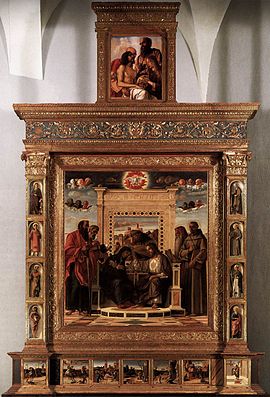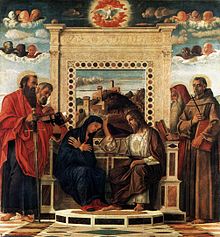Pesaro Altarpiece (Bellini)
| Pesaro Altarpiece | |
|---|---|
 | |
| Artist | Giovanni Bellini |
| Year | c. 1471–1483 |
| Medium | oil on panel |
| Dimensions | 262 cm × 240 cm (103 in × 94 in) |
| Location | Civic Museum of Palazzo Mosca, Pesaro |
The Pesaro Altarpiece (Italian: Pala di Pesaro) is an oil-on-panel painting by the Italian artist Giovanni Bellini, dated to some time between 1471 and 1483. It is considered one of Bellini's first mature works, though there are doubts on its dating and on who commissioned it. The work's technique is not only an early use of oils but also of blue smalt, a by-product of the glass industry. It had already been used in the Low Countries in Bouts' 1455 The Entombment, but this marked smalt's first use in Italian art, twenty years before Leonardo da Vinci used it in Ludovico il Moro's apartments in Milan in 1492. Bellini also uses the more traditional lapis lazuli and azurite for other blues in the work.[1]
It was originally located in San Francesco church in Pesaro in Marche, when that church was suppressed under the French occupation in 1797. The altarpiece was initially moved to the city council and after various issues it was entrusted to the city's art museum, where it still hangs.[2]
Dating
No documents survive to date the altarpiece definitively. Oils only became popular in
The work shows a number of forts, such as the one held by
More recent studies by Battisti and Castelli have suggested the 1480s, linking the work's iconology to political events such as Camilla d'Aragona's regency from 1483 onwards or religious disputes of the period, such as those between the Franciscans and Dominicans. Another theory links the work to the marriage celebrations between Costanzo I Sforza and Camilla d'Aragona in 1474.
Components
Coronation of the Virgin

The main central panel shows the
Pilasters
The cornice is held up by two pilasters, each 61 cm by 25 cm and each with a single deep perspective. The left hand one shows the saints
Predella

Below the work is a
Pieta

The work was previously topped by a 106 cm by 84 cm
The pieta was separated from the main painting in 1797 and taken to
Frame
This refers to Venetian funerary monuments of the same era, such as doge
References
- ISBN 9788836611331
- ISBN 88-451-7212-0
- ISBN 888117099X
